In agile software development, user stories and epics help define a clear workflow for development teams. A well-defined user story structure breaks down large user stories into smaller, actionable tasks, aligning development teams with user needs. Writing user stories in simple language improves user perspective and keeps agile projects moving smoothly through sprints and backlogs.
At Aloa, we prioritize a strong project management framework for successful software development. Our development team works with highly vetted partners, combining agile practices and the latest tech. A dedicated product owner ensures transparency in every iteration and helps scrum teams break down complex tasks into smaller user stories, meeting stakeholders’ satisfaction.
Building on these strategies, this guide covers the essentials of user stories and a clear breakdown of the user story structure. We also dive into Epics in Agile and the benefits of breaking them down for easier implementation. By the end, you'll know how to manage a product backlog, prioritize roadmap items, and streamline workflow within scrum teams.
Let's dive in!
What Is User Story? Structure & Best Practices
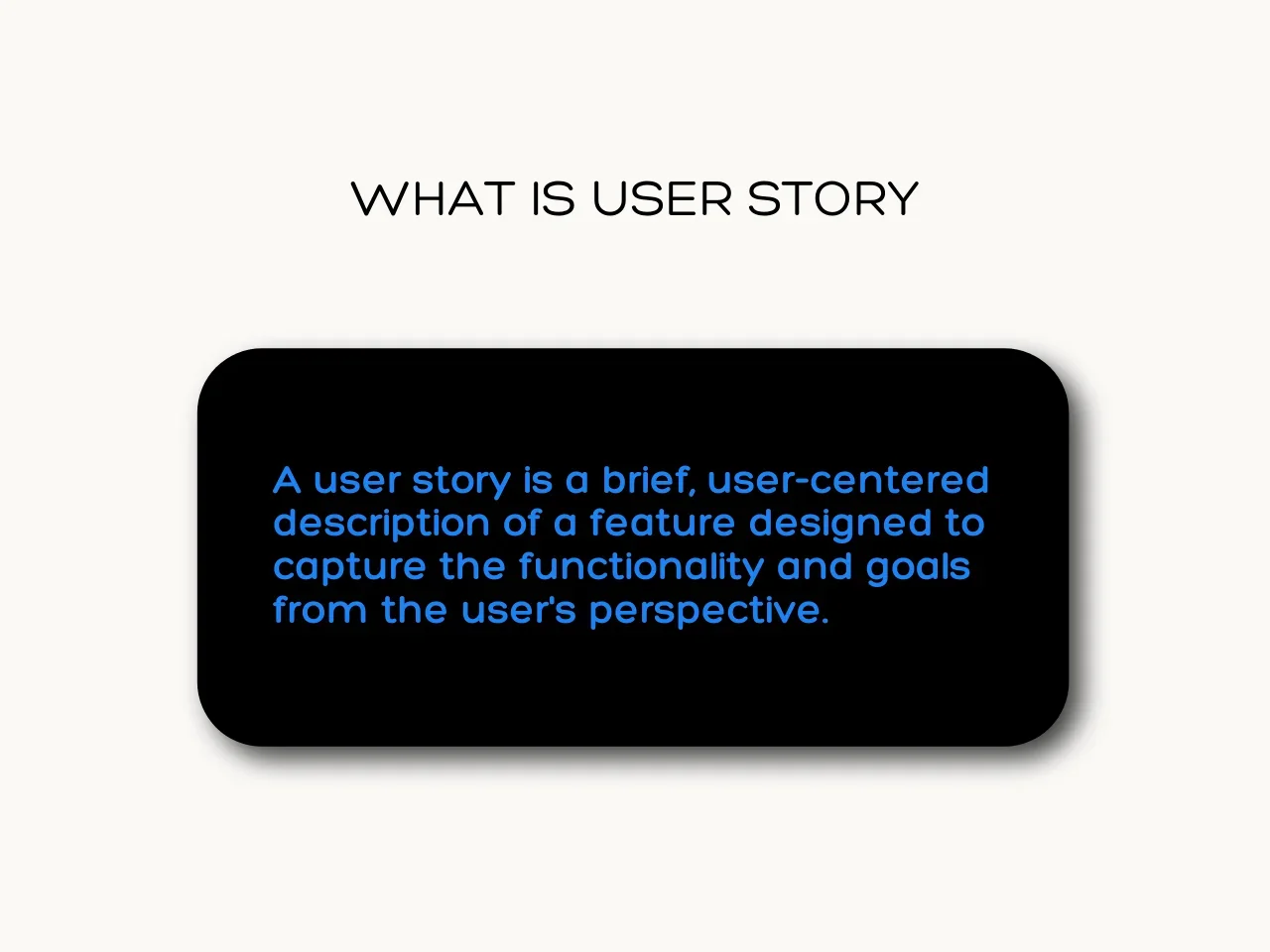
A user story is a brief, user-centered description of a feature designed to capture the functionality and goals from the user's perspective. A clear user story structure helps teams focus on the needs and outcomes, ensuring that development aligns with efficiently delivering value to the end users.
Key Components of User Story Structure
User story structure plays a crucial role in agile development, facilitating clear communication between team members and creating alignment on the goals and outcomes of each story. A well-structured user story helps transform large goals into smaller, actionable, manageable stories.
Let’s explore the main components of a good user story structure, using practical examples to guide teams in agile environments like Scrum or Kanban.
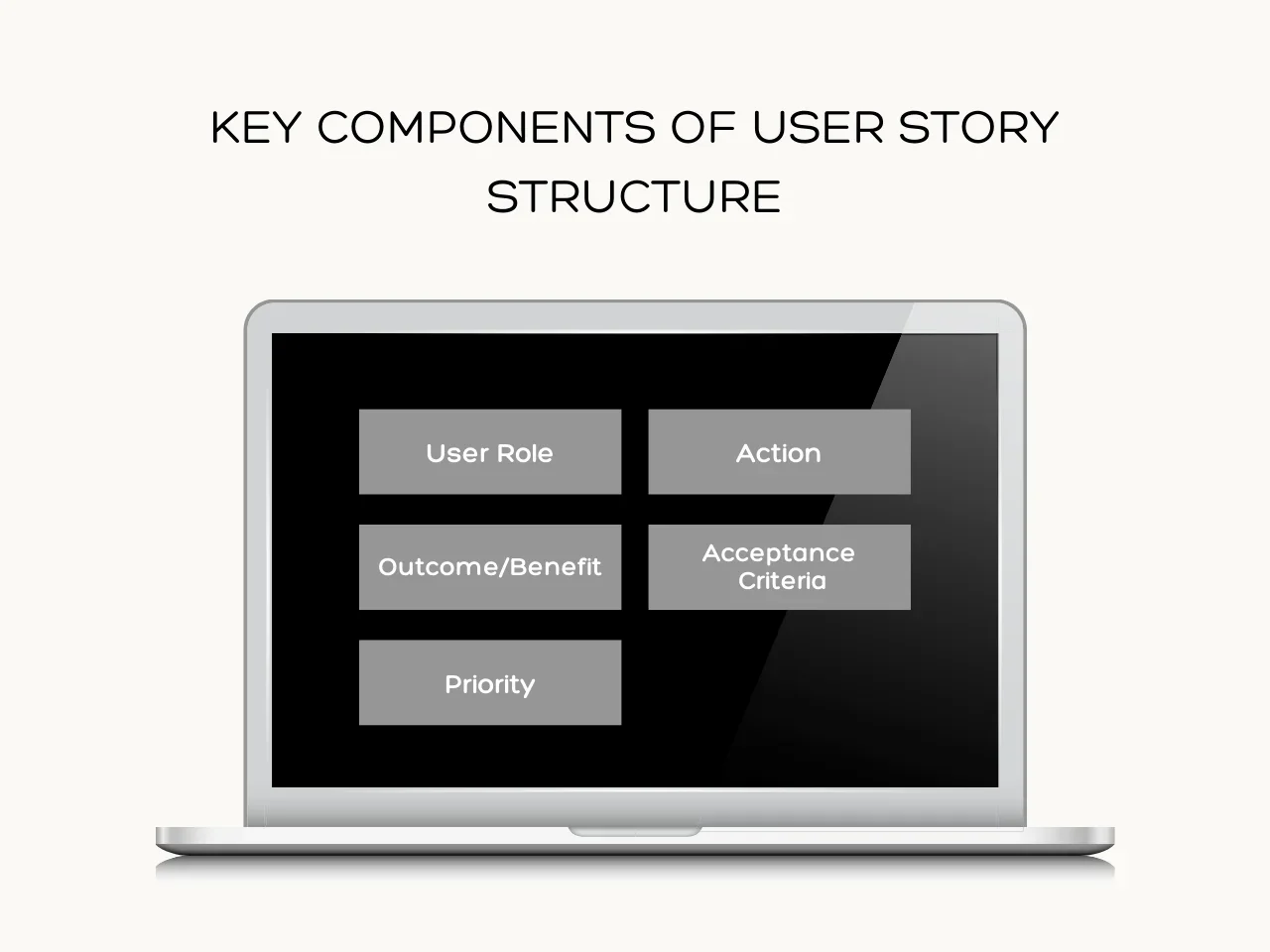
1. User Role
Every user story begins with identifying the user or team member type. The role must be clear to ensure everyone understands who will benefit from the story. A user story template often starts with “As a user/team member...”. This user role guides the creation of smaller stories and keeps the project user-focused.
2. Action
The next step defines the action the user will perform, directly relating to the desired outcome of the story. For example, “As a customer, I want to add items to my shopping cart.” Keeping the action simple and specific ensures the team can break down the task into smaller stories.
3. Outcome/Benefit
Every user story must outline the outcome/benefit of completing the action, answering the question, “Why does this matter?” For instance, “so that I can review my items before checkout.” This highlights the conditions of satisfaction, helping the team understand what makes a story successful.
4. Acceptance Criteria
Acceptance criteria are essential to any user story structure. They set the conditions of satisfaction for the story and confirm that it meets the user’s needs. Tools like Atlassian Jira allow teams to document the acceptance criteria and track whether each product backlog item meets expectations.
5. Priority
Prioritizing stories in the backlog ensures the most critical features get attention first. Agile teams rank stories based on their impact on the user feedback cycle, using techniques like index cards or digital tools to rank stories based on value. In many cases, larger agile epics are broken down into smaller stories, which then get prioritized based on the team’s needs.
Best Practices for Writing User Stories for Developers
Creating a solid user story structure can significantly improve communication between developers and stakeholders. A well-crafted user story outlines specific needs, ensuring everyone understands the task. Clear and concise user stories enable teams to stay on track and deliver quality results within sprints.
Here are five best practices to follow when writing user stories for developers:
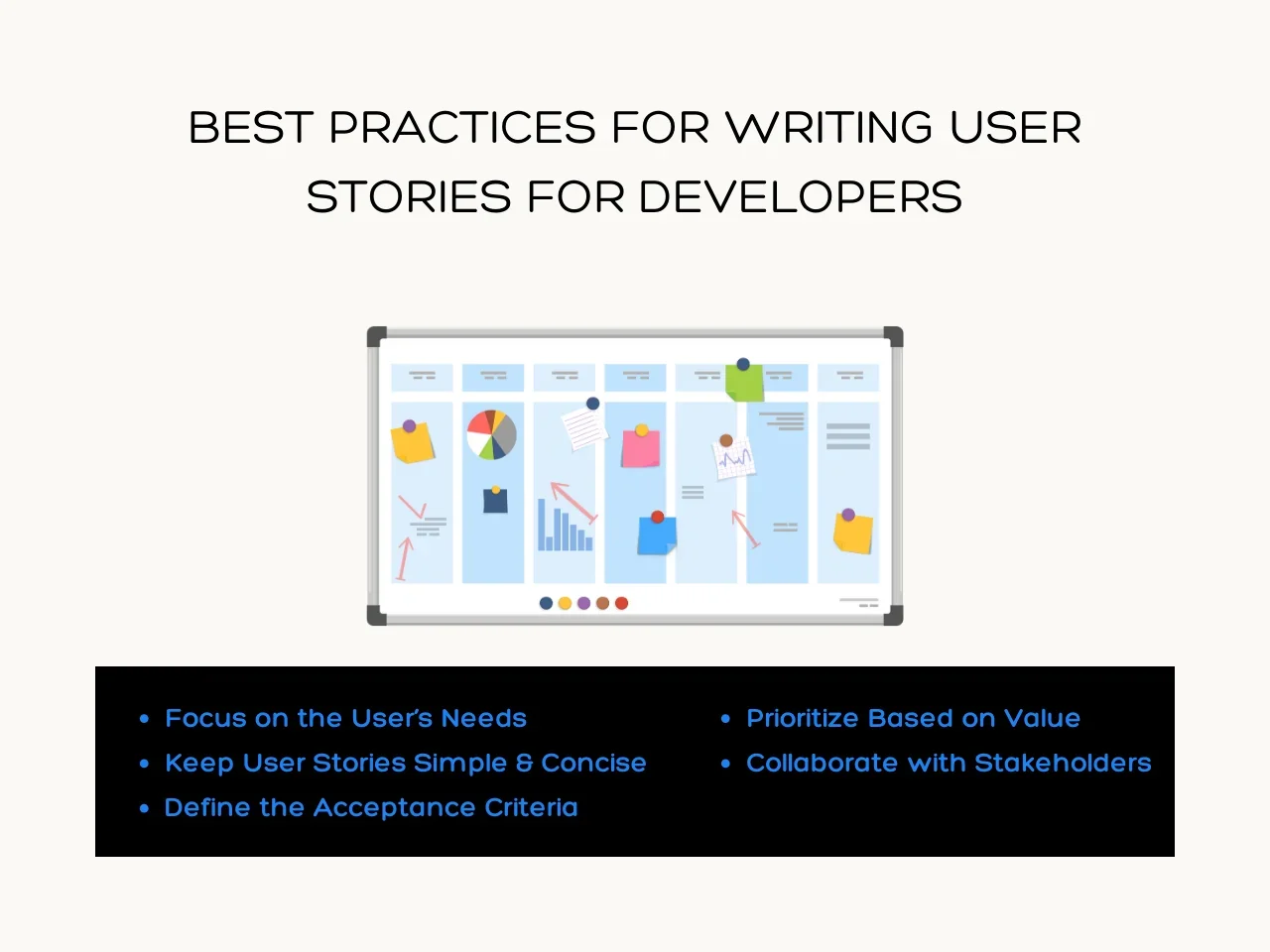
1. Focus on the User’s Needs
Always approach a user story from the user's perspective. Developers need to understand who the end user is and what problems they face. Start with phrases like, "As a user, I want to..." This format helps clarify what the user expects from the product and provides clear guidance to developers.
2. Keep User Stories Simple and Concise
Clarity is key when creating an effective user story structure. Avoid including too much detail in a single story. If a story covers too much, break it into smaller, manageable parts. Smaller stories make it easier for developers to focus on specific tasks and deliver them quickly. Use precise language and avoid technical jargon unless necessary.
3. Define the Acceptance Criteria
Each user story should include clear acceptance criteria to specify what needs to be done for the story to be considered complete. For example, “The user should be able to log in with a valid username and password.” This ensures that developers understand what success looks like and helps avoid misunderstandings.
4. Prioritize Based on Value
Prioritize stories that offer the most value to the user, focusing on features or improvements that provide immediate benefits. A well-prioritized user story structure ensures that the most critical stories are addressed first, allowing for a more efficient development process.
5. Collaborate with Stakeholders
Creating user stories should involve collaboration. Developers should work closely with stakeholders, including product owners and end users, to refine each story. By gathering insights directly from the source, developers gain a deeper understanding of the user’s needs. This collaboration leads to more relevant and actionable stories.
Epics in Agile
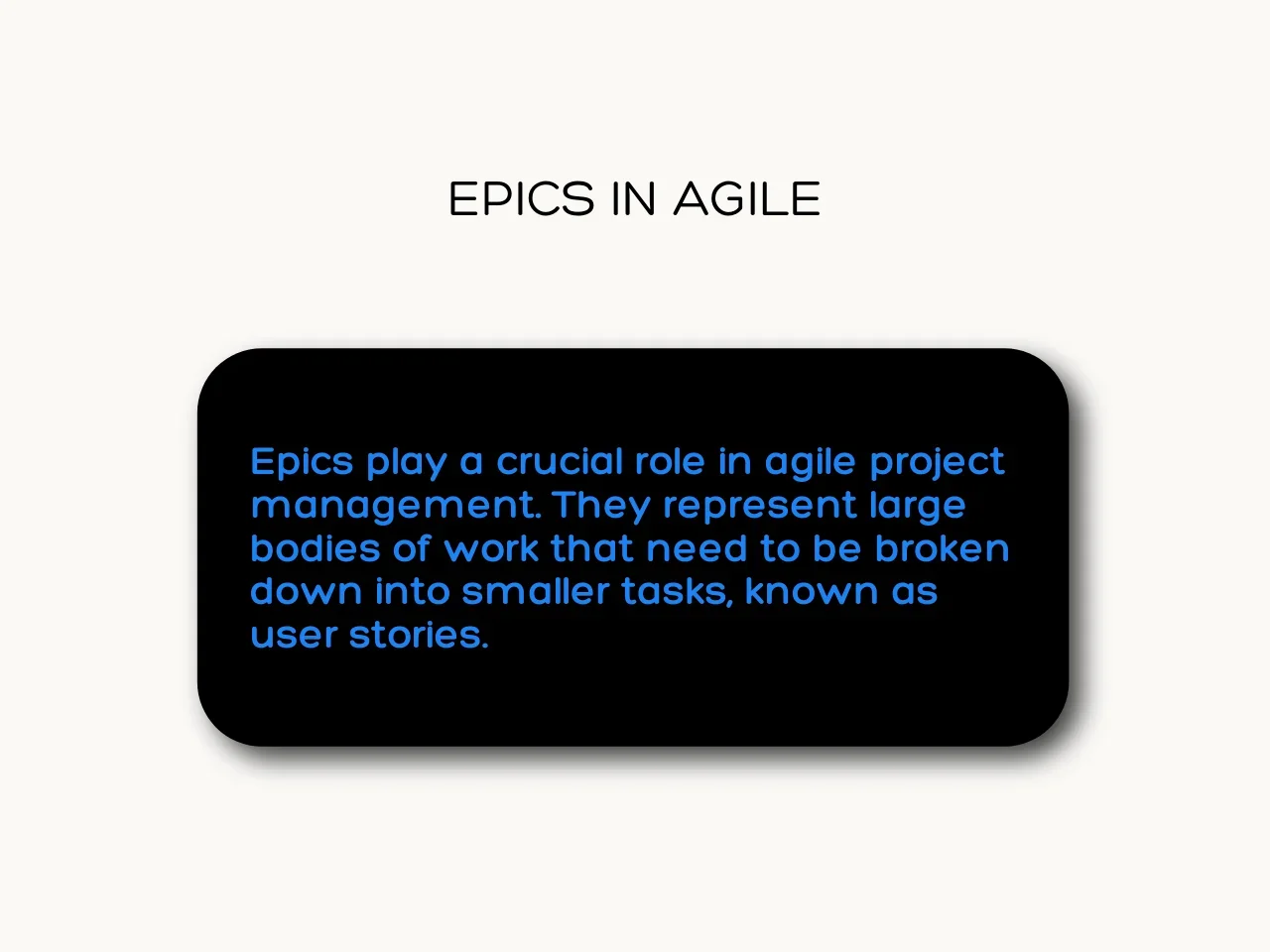
Epics play a crucial role in agile project management by representing large bodies of work that need to be broken down into smaller tasks, known as user stories. Understanding the relationship between epics and user stories helps teams manage projects efficiently. A well-defined user story structure ensures the project flows smoothly and goals remain clear.
How to Create an Epic
Creating an epic is essential for managing large tasks in agile projects. Epics help teams break down complex, overarching goals into smaller, actionable user stories. With a clear user story structure, managing epics becomes much easier. Understanding how to create an epic involves knowing when to use one and how to transition it into manageable pieces for development teams.
Here’s a step-by-step guide to creating an epic.
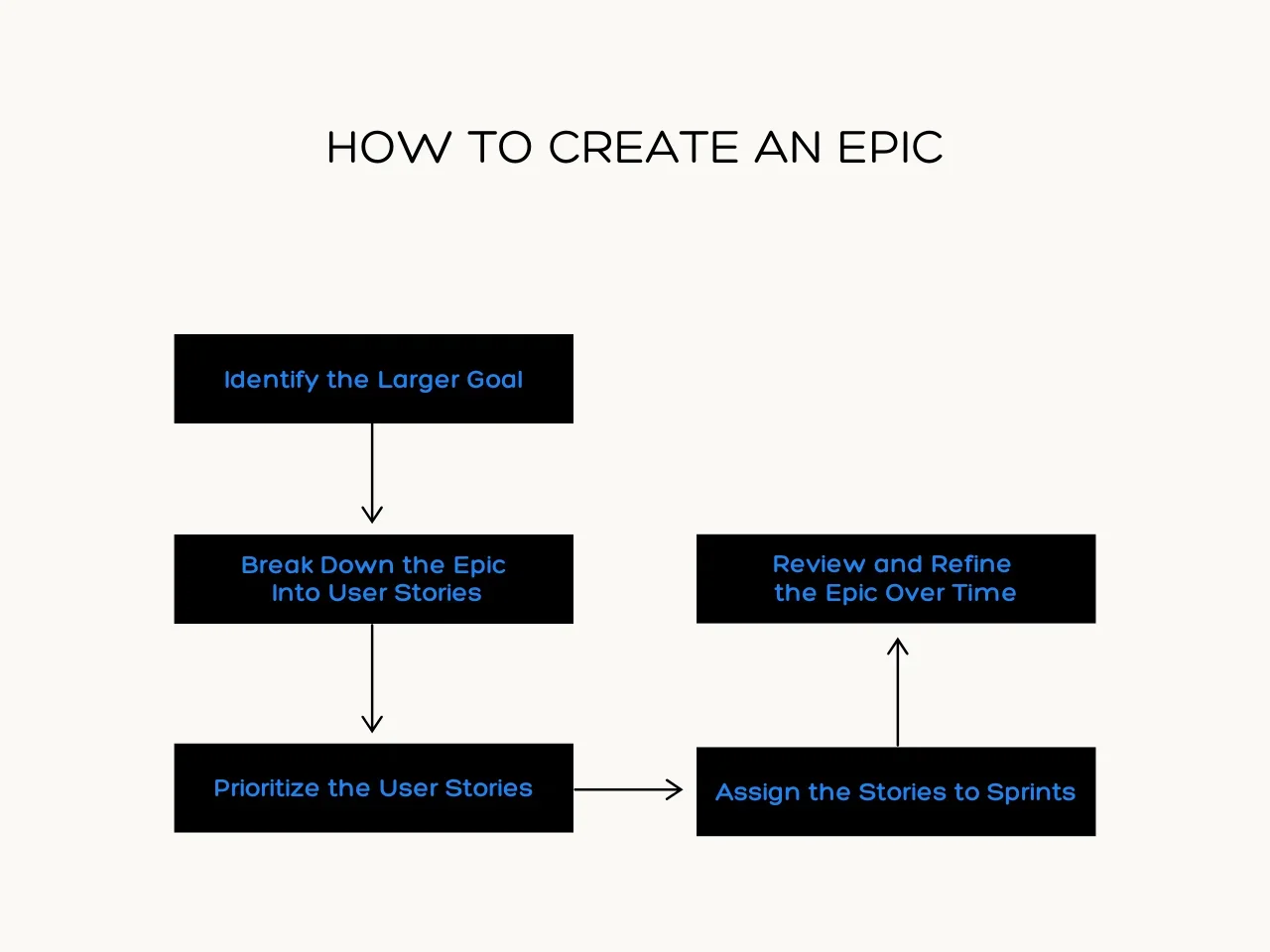
Step 1: Identify the Larger Goal
Start with identifying the broader goal that your team aims to accomplish. This goal should be too large for one sprint and require breaking it into multiple user stories. For example, if your project involves building an entire new feature for your software, this feature becomes the epic. Keeping the user story structure in mind, define the desired outcome without diving into the technical details. Focus on what value this epic delivers to the user.
Step 2: Break Down the Epic Into User Stories
Once you've identified the large goal, break it into smaller, manageable user stories. Each story should follow the user story structure format:
"As a [user], I want to [action], so that [benefit]."
This helps clarify each step and makes it easier for developers to take action on specific tasks. Splitting the epic into stories enables teams to make incremental progress, delivering value through each sprint.
Step 3: Prioritize the User Stories
After breaking the epic into user stories, prioritize them based on importance and complexity. The highest-priority stories should align with your team's immediate goals. Prioritizing the stories according to their impact on the product's overall development is essential. This step ensures that your team tackles the most critical parts of the epic first, optimizing the workflow to align with the user story structure.
Step 4: Assign the Stories to Sprints
Once prioritized, assign the user stories to upcoming sprints. Each story should be small enough to complete within a single sprint. Teams should avoid carrying user stories across multiple sprints, which can slow progress. Organizing the stories with a clear user story structure helps teams deliver value quickly and efficiently while keeping the larger epic in focus.
Step 5: Review and Refine the Epic Over Time
An epic is not a static entity. As the project progresses, review the epic regularly. Refine it if necessary, breaking it into additional user stories or adjusting priorities based on project needs. Agile projects often evolve, and the user story structure allows flexibility while keeping the project on track. Regularly reviewing the epic ensures teams stay aligned with the overall goal, making necessary adjustments for continued progress.
Benefits of Using Epics in Agile
Using epics provides multiple benefits within an agile framework. They help teams maintain a clear vision while managing the complexities of large projects.
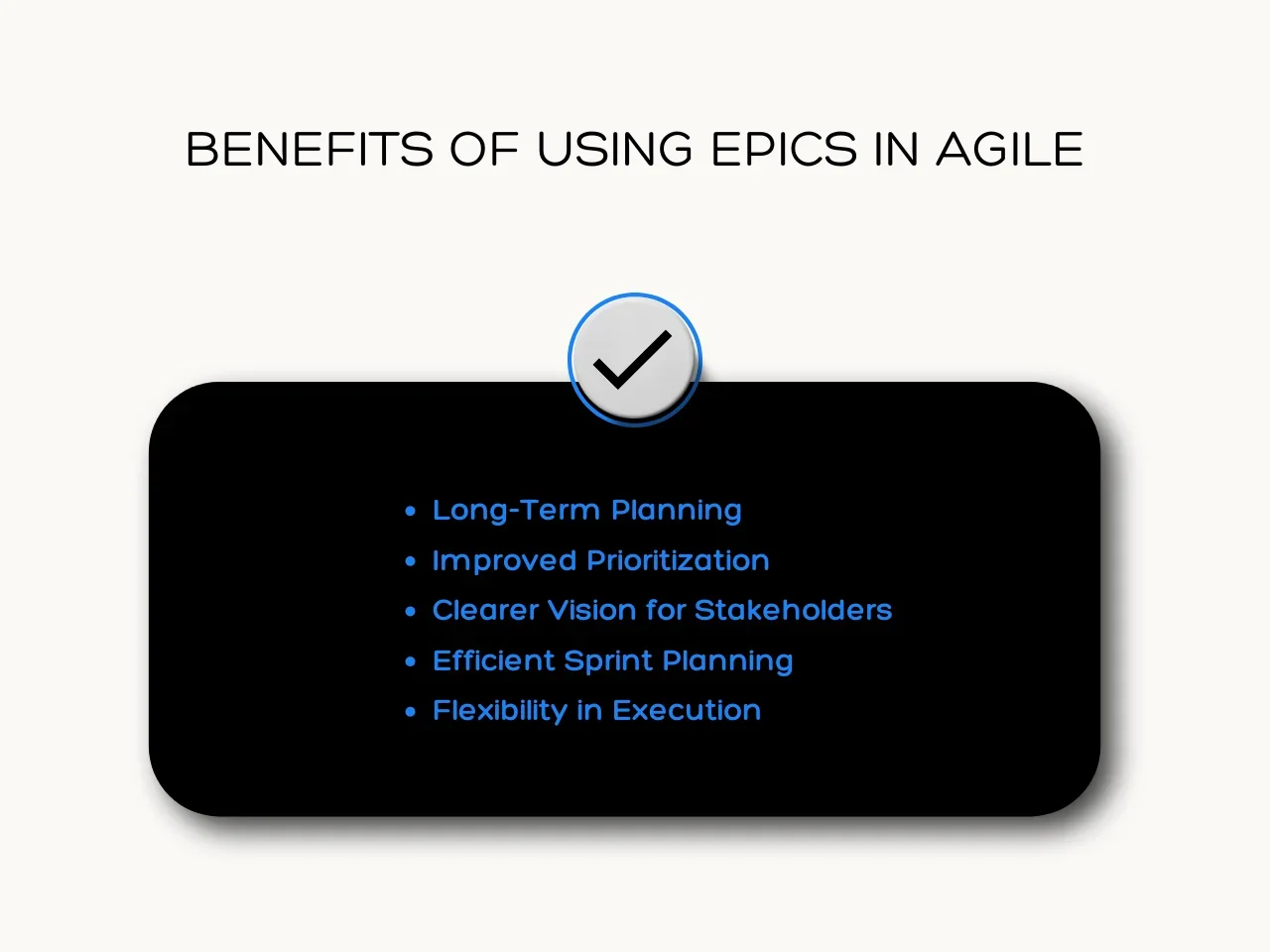
1. Long-Term Planning
Epics allow teams to focus on big-picture goals without getting bogged down in small details too early. Breaking down these large goals into smaller pieces ensures the project stays on track. This method of structuring work enables better timeline management and resource allocation.
2. Improved Prioritization
Epics help teams prioritize features effectively. They ensure high-value, long-term goals stay visible on the roadmap while allowing flexibility in the day-to-day task management with user stories. By setting a clear epic, teams can prioritize user stories that contribute directly to the larger objective.
3. Clearer Vision for Stakeholders
Stakeholders often need to understand the overarching goals of a project. Epics make it easier to communicate these high-level plans without diving into the granular details of individual user stories. This simplifies discussions around timelines, deliverables, and outcomes.
4. Efficient Sprint Planning
Teams can better manage sprint planning by breaking epics into smaller user stories. This ensures that work remains organized and tasks are achievable within the sprint. Epics provides a framework that guides the workload distribution to match the team's capacity.
5. Flexibility in Execution
Teams using epics can adjust the specifics of user stories based on evolving project needs without changing the overall objective. This flexibility ensures that agile teams remain adaptable while maintaining focus on the broader goal. This adaptability enhances the overall user story structure, ensuring each task aligns with the larger epic.
Differences Between Epics and User Stories
Understanding the user story structure is critical when working in agile development. Many teams use epics and user stories to manage tasks and goals. While both are essential, they serve different purposes within a project. Epics provide a high-level overview of broader objectives, while user stories focus on specific tasks that deliver value within a sprint.
Let’s break down the key differences between epics and user stories:
| Aspects | Epics | User Stories |
| Scope | Broad, high-level objectives | Specific, focused tasks |
| Time Frame | Spans multiple sprints or releases | Completed within a single sprint |
| Programming Language | Requires a basic understanding of programming languages | Does not require any knowledge of programming languages |
| Detail | General, requires breaking down | Detailed and actionable |
| Purpose | Guides long-term project vision | Delivers immediate value to the users |
| Size | Larger, involves multiple stories | Smaller, focused on one feature |
| Outcome | Leads to the completion of major goals | Provides a tangible product increment |
Epics help teams organize their work into manageable parts, while user stories ensure specific tasks are completed efficiently. Structuring your epic user story setup keeps the project on track and ensures clarity for developers and stakeholders.
With a clear user story structure, teams can transition from big-picture epics to smaller, actionable user stories, aligning goals with sprints. This approach maximizes productivity and helps manage the product backlog effectively. A good balance between epics and user stories allows for smoother project flow, clear priorities, and better results.
Key Takeaway
An organized user story structure helps teams manage agile projects effectively. Epics and user stories are essential in breaking down complex tasks into manageable steps. Epics represent larger goals, while user stories focus on specific actions that provide value to the user. This structure ensures teams can deliver features incrementally, keeping projects on track and stakeholders informed.
A strong user story structure supports agile project management through better communication and collaboration. With clear expectations and defined outcomes, teams can prioritize tasks and maintain a smooth workflow. This approach encourages continuous improvement while delivering quality results at every sprint. Your team can refine their process using tools like Scrum user story examples, templates, and real-world use cases.
Are you ready to enhance your software project management and streamline user story structure? At Aloa, we help you create, manage, and optimize user stories to ensure project success from start to finish.

